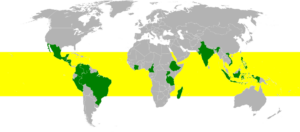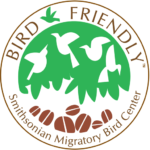By Liz Neroni, Naturalist
We all have our routines. One of mine is having a cup of coffee in the morning – and I’m not the only one. Many of the people I know have this beverage somehow embedded in their everyday lives. Everywhere I turn, there are social media posts, radio and TV commercials, billboards, and of course actual coffee shops. There are even complimentary stations set up in unrelated businesses, entire aisles within grocery stores dedicated to it, and thousands of other products created all for one thing: coffee!

When you think of all those aspects and how it really has become a part of our culture, it isn’t surprising that approximately 2.5 billion cups are consumed every day. That is a lot of coffee, but what is it? Where does it come from? It is a tropical evergreen shrub that typically has waxy green leaves. The fruit, called the cherry, grows from the branches of the shrub. The bean, or seed, within the fruit is what is harvested.
These plants only grow in the “Bean Belt” which is shown in green on the map. To me, this seems like a limited area for a product in such a high demand from the rest of the world. It made me think about the whole process and the impact this one item has on the environment, and I found that not all coffee is the same. I’m not referring to the different types of beans or how they vary in flavor. I’m talking about the fact that some coffee is grown with nature in mind and some is not. Some coffee is grown in full sun, in monocultures. This means land has been clear cut just to grow coffee. Not only does this method destroy habitat biodiversity, it also causes erosion, opens the door to blights and pests, and requires chemicals to maintain. However, this allows growers to get a larger yield and the coffee is easier to harvest. Other farms focus on organic shade grown coffee. This means that the plants are mixed within the natural surroundings and are typically harvested by hand. It might be harder work, but the payoff for the environment is extraordinary.
If you want to buy an eco-friendlier brand, look for BIRD FRIENDLY CERTIFIED coffee. There are other certifications out there, and they also do good work. However, if you see this “bird friendly” symbol on the packaging, you are buying a product with the highest standards to ensure habitat protection, including vital space for migrating birds. Other ways you can help in regard to coffee include composting the grounds and not using one-time products like Kcups, containers, and straws.
 You can try coffee with this certification and learn even more during the Steps to Sustainability class on January 6 . There is limited space for this free class, so visit www.preservationparks.com/events and sign up today.
You can try coffee with this certification and learn even more during the Steps to Sustainability class on January 6 . There is limited space for this free class, so visit www.preservationparks.com/events and sign up today.







